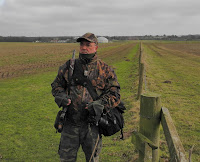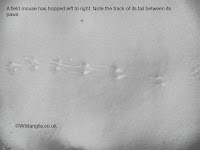
 February is possibly the worst month of the
year for the airgun hunter. Winters die-back is at its maximum. Cold winds
pierce even the densest thickets and very few wild creatures venture from drey
or nest or den for long. The crops are at a cusp. The winter beet or barley
long since drawn from the soil and the spring shoots now battling to break
through the hoary, brittle earth. Those that do are plucked and plundered by
legions of sharp-beaked rooks and
gluttonous wood-pigeons. As I wander the fields and spinneys, I thank the lord
for my solid constitution as the bird-scarers are dotted all over. Hidden in
hedgerow and hollow, it pays to know where these little cannons are and how
often they are set to fire. If you find yourself close to one accidently .. and
it discharges .. you’ll hope you’ve tied the ankles of your cargo pants!
February is possibly the worst month of the
year for the airgun hunter. Winters die-back is at its maximum. Cold winds
pierce even the densest thickets and very few wild creatures venture from drey
or nest or den for long. The crops are at a cusp. The winter beet or barley
long since drawn from the soil and the spring shoots now battling to break
through the hoary, brittle earth. Those that do are plucked and plundered by
legions of sharp-beaked rooks and
gluttonous wood-pigeons. As I wander the fields and spinneys, I thank the lord
for my solid constitution as the bird-scarers are dotted all over. Hidden in
hedgerow and hollow, it pays to know where these little cannons are and how
often they are set to fire. If you find yourself close to one accidently .. and
it discharges .. you’ll hope you’ve tied the ankles of your cargo pants!
 The close of this dank, grey month is
marked with the signs of re-birth and regeneration. With the slightest hint of
sunshine, songbirds chase and flutter like the opening scene of a Disney movie.
Out on the open plough, the brown hares (or ’dewhoppers’ as they are often
called locally) are starting the courting game. Over the next few weeks they’ll
be chasing and boxing. Contrary to popular belief this isn’t the hares equivalent
of the deer rut .. males fighting for territory and supremacy. The one throwing
the punches is normally the feisty female resisting a males amorous advances.
Nothing new there then!
The close of this dank, grey month is
marked with the signs of re-birth and regeneration. With the slightest hint of
sunshine, songbirds chase and flutter like the opening scene of a Disney movie.
Out on the open plough, the brown hares (or ’dewhoppers’ as they are often
called locally) are starting the courting game. Over the next few weeks they’ll
be chasing and boxing. Contrary to popular belief this isn’t the hares equivalent
of the deer rut .. males fighting for territory and supremacy. The one throwing
the punches is normally the feisty female resisting a males amorous advances.
Nothing new there then!  This time of year normally sees me busy
with the camera and catching up on shoot housekeeping. I’ll be walking my
shooting permissions clearing regular stalking paths of briar suckers, cutting
back intrusive branches, oiling squeaky gates and removing those exposed
stretches of barbed wire revealed in the grass. Anything to make a quiet and
unobstructed traverse of the land easier when the growth returns. While the
foliage is at its full ebb, I will check all the warrens and identify the live
buries. I’ll mark last years magpie and jays nests .. for both are likely to
build again nearby. If they survived my attention last season they might not be
so lucky this year.
This time of year normally sees me busy
with the camera and catching up on shoot housekeeping. I’ll be walking my
shooting permissions clearing regular stalking paths of briar suckers, cutting
back intrusive branches, oiling squeaky gates and removing those exposed
stretches of barbed wire revealed in the grass. Anything to make a quiet and
unobstructed traverse of the land easier when the growth returns. While the
foliage is at its full ebb, I will check all the warrens and identify the live
buries. I’ll mark last years magpie and jays nests .. for both are likely to
build again nearby. If they survived my attention last season they might not be
so lucky this year.
This year I’m praying that the rabbits
return in numbers. Last years dearth here in Norfolk has left me with a
depleted freezer and I like my free coney meat! Though this winters roost
shooting has put plenty of pigeon breasts in there, they need the compliment of
rabbit in a pie or casserole. Signs so far are good. A few kits about (rabbits
breed in every month now) and both they and the parents look healthy. Much as
it would pain my farmers, for the first time ever I have imposed a short close
season on coneys. I could have shot two plump adults on todays walkabout but
chose to let what looked fit and clean coneys survive to breed. I would far
rather farm them and collect good, healthy meat later than simply annihilate
them.
 I was delighted to see a pair of courting
buzzards over the farm I walked today. Some readers may find that a strange
statement but it has taken nearly 20 years for the buzzard to re-establish a
good presence out here in the East. Buzzards, to me, mean rabbits and
vice-versa. The raptors presence is an indicator of ecological diversity and I
can forgive it the theft of the odd pheasant poult. Last week, while roost
shooting, I dropped a pigeon onto the woodland floor with a long shot. I left
it there to wait for others flighting in. After a minute or two I saw a grey
head bobbing through the brash on the floor. Damn it! I’d winged the pigeon and
was about to set off on that ’chase to despatch’ scenario when suddenly a huge
dark bird ghosted down from the canopy and clasped onto the pigeon. The buzzard
must have been watching me for ages. The bird stared at me for a half a minute,
that angry yellow eye telling me “That, sir, is how to finish a pigeon!”. Then
he took off and floated out of the copse, leaving the dead pigeon where it laid ..
and leaving me flabbergasted.
I was delighted to see a pair of courting
buzzards over the farm I walked today. Some readers may find that a strange
statement but it has taken nearly 20 years for the buzzard to re-establish a
good presence out here in the East. Buzzards, to me, mean rabbits and
vice-versa. The raptors presence is an indicator of ecological diversity and I
can forgive it the theft of the odd pheasant poult. Last week, while roost
shooting, I dropped a pigeon onto the woodland floor with a long shot. I left
it there to wait for others flighting in. After a minute or two I saw a grey
head bobbing through the brash on the floor. Damn it! I’d winged the pigeon and
was about to set off on that ’chase to despatch’ scenario when suddenly a huge
dark bird ghosted down from the canopy and clasped onto the pigeon. The buzzard
must have been watching me for ages. The bird stared at me for a half a minute,
that angry yellow eye telling me “That, sir, is how to finish a pigeon!”. Then
he took off and floated out of the copse, leaving the dead pigeon where it laid ..
and leaving me flabbergasted. .JPG)
























.JPG)

.jpg)




















